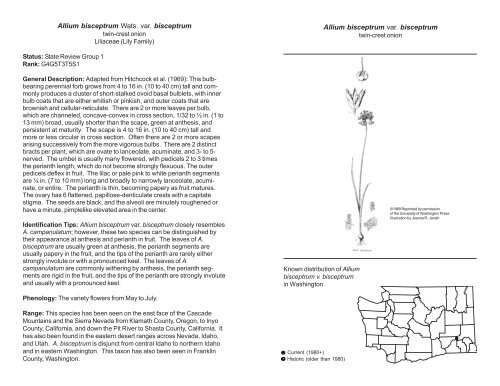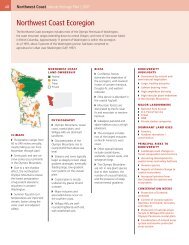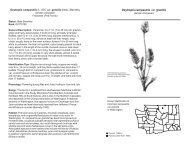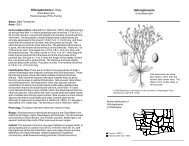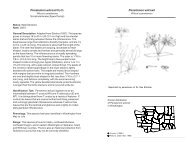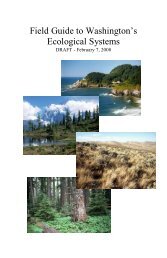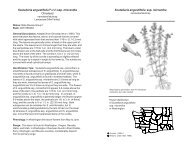Allium bisceptrum var. bisceptrum
Allium bisceptrum var. bisceptrum
Allium bisceptrum var. bisceptrum
Create successful ePaper yourself
Turn your PDF publications into a flip-book with our unique Google optimized e-Paper software.
<strong>Allium</strong> <strong>bisceptrum</strong> Wats. <strong>var</strong>. <strong>bisceptrum</strong><br />
twin-crest onion<br />
Liliaceae (Lily Family)<br />
Status: State Review Group 1<br />
Rank: G4G5T3T5S1<br />
General Description: Adapted from Hitchcock et al. (1969): This bulbbearing<br />
perennial forb grows from 4 to 16 in. (10 to 40 cm) tall and commonly<br />
produces a cluster of short-stalked ovoid basal bulblets, with inner<br />
bulb coats that are either whitish or pinkish, and outer coats that are<br />
brownish and cellular-reticulate. There are 2 or more leaves per bulb,<br />
which are channeled, concave-convex in cross section, 1/32 to ½ in. (1 to<br />
13 mm) broad, usually shorter than the scape, green at anthesis, and<br />
persistent at maturity. The scape is 4 to 16 in. (10 to 40 cm) tall and<br />
more or less circular in cross section. Often there are 2 or more scapes<br />
arising successively from the more vigorous bulbs. There are 2 distinct<br />
bracts per plant, which are ovate to lanceolate, acuminate, and 3- to 5nerved.<br />
The umbel is usually many flowered, with pedicels 2 to 3 times<br />
the perianth length, which do not become strongly flexuous. The outer<br />
pedicels deflex in fruit. The lilac or pale pink to white perianth segments<br />
are ¼ in. (7 to 10 mm) long and broadly to narrowly lanceolate, acuminate,<br />
or entire. The perianth is thin, becoming papery as fruit matures.<br />
The o<strong>var</strong>y has 6 flattened, papillose-denticulate crests with a capitate<br />
stigma. The seeds are black, and the alveoli are minutely roughened or<br />
have a minute, pimplelike elevated area in the center.<br />
Identification Tips: <strong>Allium</strong> <strong>bisceptrum</strong> <strong>var</strong>. <strong>bisceptrum</strong> closely resembles<br />
A. campanulatum; however, these two species can be distinguished by<br />
their appearance at anthesis and perianth in fruit. The leaves of A.<br />
<strong>bisceptrum</strong> are usually green at anthesis, the perianth segments are<br />
usually papery in the fruit, and the tips of the perianth are rarely either<br />
strongly involute or with a pronounced keel. The leaves of A.<br />
campanulatum are commonly withering by anthesis, the perianth segments<br />
are rigid in the fruit, and the tips of the perianth are strongly involute<br />
and usually with a pronounced keel.<br />
Phenology: The <strong>var</strong>iety flowers from May to July.<br />
Range: This species has been seen on the east face of the Cascade<br />
Mountains and the Sierra Nevada from Klamath County, Oregon, to Inyo<br />
County, California, and down the Pit River to Shasta County, California. It<br />
has also been found in the eastern desert ranges across Nevada, Idaho,<br />
and Utah. A. <strong>bisceptrum</strong> is disjunct from central Idaho to northern Idaho<br />
and in eastern Washington. This taxon has also been seen in Franklin<br />
County, Washington.<br />
Known distribution of <strong>Allium</strong><br />
<strong>bisceptrum</strong> v. <strong>bisceptrum</strong><br />
in Washington<br />
Current (1980+)<br />
Historic (older than 1980)<br />
<strong>Allium</strong> <strong>bisceptrum</strong> <strong>var</strong>. <strong>bisceptrum</strong><br />
twin-crest onion<br />
©1969 Reprinted by permission<br />
of the University of Washington Press.<br />
Illustration by Jeanne R. Janish
<strong>Allium</strong> <strong>bisceptrum</strong> <strong>var</strong>. <strong>bisceptrum</strong><br />
twin-crest onion<br />
Photo by Gary A. Monroe<br />
Photo by Gary A. Monroe<br />
Photo by Gary A. Monroe<br />
2003 Produced as part of a cooperative project between the Washington Department of Natural Resources, Washington<br />
Natural Heritage Program and the U.S.D.I. Bureau of Land Management. Persons needing this information in an<br />
alternative format, call (360) 902-1600 or TTY (360) 902-1125.<br />
<strong>Allium</strong> <strong>bisceptrum</strong> <strong>var</strong>. <strong>bisceptrum</strong><br />
twin-crest onion<br />
Habitat: This taxon occurs in meadows and aspen groves and grows<br />
less frequently on open slopes. In Washington, this taxon has been<br />
found at an elevation of 850 ft (259 m). This generally high-elevation<br />
plant is found in other regions from 6562 to 9514 ft (2000 to 2900 m).<br />
Associated species in Washington include sagebrush (Artemisia sp.),<br />
clematis (Clematis sp.), rose (Rosa sp.), brome (Bromus sp.),<br />
chokecherry (Prunus virginiana), poison ivy, oak, and sumac (Toxicodendron<br />
spp.), thistle (Cirsium sp.), and sedge (Carex sp).<br />
Ecology: This plant prefers the damp shade of aspen groves or open<br />
meadows in the pinyon-juniper and subalpine zones. In Washington, the<br />
one known population was found on bench above a river in a highly<br />
disturbed shrub steppe.<br />
State Status Comments: Only one small population has been found in<br />
the state. The Washington Natural Heritage Program needs more<br />
information before assigning an accurate status.<br />
Inventory Needs: Franklin County should be systematically surveyed<br />
for additional occurrences and updated information about these populations<br />
should be collected. The one documented occurrence should be<br />
re-visited and its identification should be confirmed.<br />
Threats and Management Concerns: Serious threats include competition<br />
from non-natives, trampling, and grazing.<br />
References:<br />
Anderson, M.K. Aspen Onion. Plant Guide. Natural Resources<br />
Conservation Guide. United States Department of Agriculture.<br />
August 14, 2003.<br />
Hitchcock, C.L., A. Cronquist, M. Ownbey, J.W. Thompson. 1969.<br />
Vascular Plants of the Pacific Northwest Part 1: Vascular Cryptogams,<br />
Gymnosperms, and Monocotyledons. University of Washington<br />
Press, Seattle, WA. 914 pp.<br />
2003 Produced as part of a cooperative project between the Washington Department of Natural Resources, Washington<br />
Natural Heritage Program and the U.S.D.I. Bureau of Land Management. Persons needing this information in an<br />
alternative format, call (360) 902-1600 or TTY (360) 902-1125.


